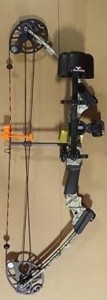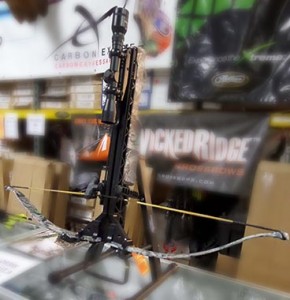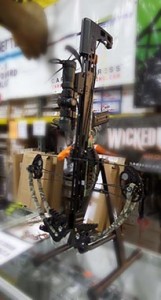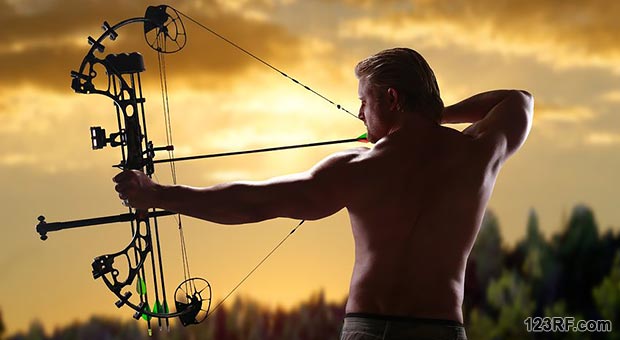If you haven’t touched a bow and arrow since gym archery classes, then you may not realize both vintage and new models hold a valuable place in hunting and survival.
As with choosing the right gun or knife, you may find that one bow type and accessories will work better than others. As long as you choose a model that you can use easily and effectively, it will go a long way towards helping you provide food and protect yourself when SHTF.
Basic Bow Types
From early times, humans could hunt, fish, or defend at a distance with a bow and arrows. The first bow, or Long Bow, was nothing more than a thick branch with animal gut tied to each end to serve as the bow string.
As time went on the bows became longer and heavier. Their range became longer until shooting and hitting a target at over 100 yards was the norm. The main bow variations in use today include:
- Recurve Bow – has an additional curve on each end which magnifies the power of draw to increase distance, speed, and accuracy.
- Compound bows – uses a cam system to create a smooth draw, high lift-off, and a more powerful arrow flight.
- Crossbow – This bow is held horizontal to the ground. It has a stock mounted at the center of the bow arms, which can be used to mount scopes, and serve as the bolt path. A foot stirrup is located on the front center of the bow, and is used to pull the string back and arm the bow. Since the bow arms are thicker and heavier, the crossbow superior to standard bows. To fire, place a bolt in the groove, aim, and pull the trigger. As with standard bows, you can buy recurve and compound designs. Modern body armor cannot stop a bolt from a good quality crossbow, but can usually deflect arrows from conventional bows.
WARNING: When shooting a crossbow, keep a tight hold the hand grip, and do not allow your fingers to slide upward, or the string will cut your fingers off with ease.
Related:KodaBow Bravo Zulu
Long Bow
This bow was made from the heart wood of the Ash, Yew, or the Oak tree, and should be the same height as the person using it. Traditionally this bow does not use modern sights thus the accuracy may not be as good as modern bows, but in its day it was good enough to put food on the table or kill an enemy.
This is a weapon that should not be under estimated. Long bow costs range from $88.00- $583.99, and are usually made from wood or fiberglass, although I made my bow many years ago from Ash wood and deer gut.
Recurve Bow
This bow is made of Ash, yew, or oak, with lamination for extra strength. Unlike the long bow, it has a curve at each end that makes it possible to take deer on the first shot with good placement.
I Prefer the Greatree Archery Deerslayer recurve bow with a 50 lb draw. The workmanship and sight on the bow are both good, and worth the 223.00 investment on this bow.
Compound Bow
 Today’s compound bows are usually made from light weight materials such as Carbon or Fiberglass with an aluminum riser. This bow has three main advantages:
Today’s compound bows are usually made from light weight materials such as Carbon or Fiberglass with an aluminum riser. This bow has three main advantages:
- The pulley/cam system make it easy to use by just about anyone. A 50 pound draw can be done with less than 30 pounds of pull.
- These bows are not affected by temperature or humidity.
- Since it takes less energy to hold the string back, you can take more time to aim.
My preference – the Venture compound bow which is part of the Mission Series by Mathews, which runs around $499.00. This is a durable bow with an adjustable draw weight from 50 to 70 lbs. It makes a good starter bow for teens, yet has more than enough power for adult men and women.
Recurve Crossbow
Today’s modern recurve crossbows are the end result of applying modern materials to a classic  weapon.
weapon.
These bows are stronger, lighter, faster, and safer than their old counterparts.
My preference is, for sure, The Matrix 355 by Excalibur, which is a very good recurve crossbow priced at $899.99. This crossbow comes with a good accessory package containing a Tact-zone scope with 30mm rings, a four bolt quiver with bracket, four Diablo bolts with 150 grain field points, and a rope cocking aid.
Compound crossbow
 These bows are made from light weight, strong material that gives greater speed and accuracy than conventional crossbows.
These bows are made from light weight, strong material that gives greater speed and accuracy than conventional crossbows.
The pulley/cam systems also give greater accuracy and allow for a longer aiming time and faster second shots.
My preference is The Invader Crossbow by Ten Point Is a no nonsense hunting crossbow that runs around 500.00 for the basic package.
It comes with a Ridge-Dot 40mm multi-dot scope, self-retracting rope-cocking system, and a detachable 3 bolt quiver.

In conclusion, the bow and arrow have changed much through time, yet each type still serves an important purpose. As you search for the best bow for hunting and survival, keep in mind your physical condition and what you want to use the bow for.
Always remember that long term survival after SHTF can be seriously hampered by failure to practice, or choosing cheap equipment now that will fail to work properly later on.
This article has been written by Fred Tyrell for Survivopedia.
About Fred Tyrell
Fred Tyrrell is an Eagle Scout and retired police officer that loves to hunt, fish, hike, and camp with good friends and family. He is also a champion marksman (rifle, pistol, shotgun) and has direct experience with all of the major gun brands and their clones. Fred refers to himself as a “southern gentleman” – the last of a dying way. He believes a man’s word is his bond, and looks forward to teaching others what he has learned over the years. You can send Fred a message at editor [at] survivopedia.com.





